We simply have not found it possible to continue with the blog over the weekend as we are staying with friends who they have entertained us wonderfully, taking us off to see what the surrounding countryside has to offer. This morning they left with the dawn for their work leaving us to catch up on everything from our laundry to the blog.
So while the washing machine chugs away, Modestine snoozes with the family dog in the sunshine, Ian loads our latest batch of photos on to the internet and Jill is sheltering under a shady, open-sided pergola surrounded by geraniums and hanging baskets of flowers catching up on the text for the blog.
Our last entry covered to the end of Friday evening. On Saturday 17th we left our campsite and its unwelcome mosquitoes and made our way gently in the direction of Györ where we were expected at the home of Erzsebet and Gábor who live in the very peaceful and pleasant village of Gyömöre about 20 kilometres south of Györ. Ezsébet is a Hungarian librarian whom Ian first met during his eventful study tour of the country arranged through the Local History Group of the British Library Association. Links, both professional and personal have been maintained ever since and there are several British local history librarians who are followers of this blog who are also friends of Erzsebet. To you she sends her love and very best wishes.
Our journey, once we had left Budapest behind, was pleasant and non-eventful. There is far too much open space in Hungary in the summer and the roadsides offer no shade whatsoever. Open fields of cereals stretch far into the distance, baking beneath the relentless heat. We searched for ages for somewhere cool for a picnic lunch but it was not until we were driving along the banks of the Danube that we eventually found a patch of shade by the water. Even here there were mosquitoes so our stop was as brief as possible. We did pass through many little villages, each very pleasant but exposed amidst the open countryside that surrounded it. Streets are very wide in the villages and it does not seem customary to line them with trees as happens so frequently in France for example.
Our friends have moved since we last saw them in Györ but we found their present home in Gyömöre with no trouble. Erzsébet was absent at a meeting and Gábor does not speak English but there daughter, confusingly also called Erzsébet, and their son-in-law Andrasz entertained us admirably in English and German until Erzsébet returned. Soon we were refreshed and cool, sitting in the welcome shade of the pergola chatting in a mixture of three languages and enjoying glasses of red wine made by Erzsébet's father from the vines in his garden in this same village. Since we last saw young Erzsébet as a music student in Györ, she has married, teaches music and has two adorable little children of her own.
 Our friends' home, a traditional style arcaded house in Gyömöre
Our friends' home, a traditional style arcaded house in Gyömöre Our friends' grandchildren, Gyömöre
Our friends' grandchildren, GyömöreIt was delightful to be amongst friends again and to find the same relaxed and happy atmosphere we enjoyed when we last met. Night fell as we enjoyed a cold supper and soon we were more than ready to sleep after the heat of the day. We are just lazy I suppose, but for our friends the day starts and ends far earlier than in England. They are usually at work by 7am with thirty minutes for lunch, work supposedly ending around 4pm. This is obviously a far more practical arrangement during the hot summer months but cannot be very attractive on cold winter mornings when by law everyone has to shovel away the snow from the pavements outside their homes before going to work!
Yesterday, Sunday 18th we were up early as requested, presenting ourselves at the breakfast table at 7.30am. Our hosts cheerfully informed us they would not be eating with us as they had already eaten at breakfast time! So after fruit juice, tea and home-made apricot jam for the two of us we all drove to the nearby Sunday market. This is traditional in the family and we were joined by Erzsébet's parents, a delightful couple whom Ian has always remembered with affection. They are immensely warm and welcoming people though do not speak English. Together we spent a happy morning around the crowded open market in the nearby little town of Tét learning lots of new words as things were pointed out to us.
It was obvious why we had to be at the market so early. There was no shade and by 8.30am we were already very hot. Ian bought another sunhat to replace the latest one lost in Budapest – Europe is littered with Ian's lost sunhats! He also bought the tee shirt seen in the photo below, and for those Hungarian blog readers - yes, he did know what it meant. It just amused him and will no doubt reappear if invited for a goulash anywhere in the future!
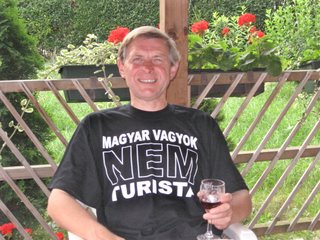 I'm a Hungarian, not a tourist!
I'm a Hungarian, not a tourist!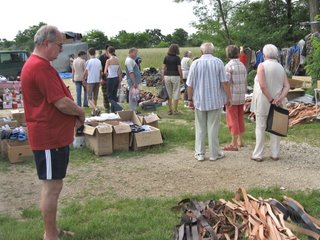 At the open air market, Tét
At the open air market, TétFamily tradition also dictates that after browsing the stalls, buying a few odds and ends and some cauliflowers for soup, we needed sustenance. So we crowded around the stall where a hot sausage seller slaved over an even hotter stove frying blood sausages and onions which were served with gherkins, mustard and hunks of heavy white bread and bottles of blissfully cold beer.
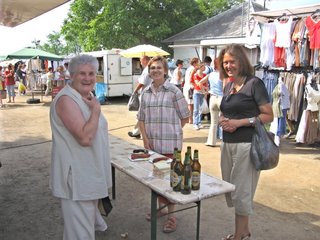 Sausage and beer stall at the open air market, Tét
Sausage and beer stall at the open air market, TétBy now it was really too hot and felt much later than mid morning. Erzsébet's parents suggested we return to their house for coffee and palinka. (You need a cast-iron gut to cope with home-made palinka though by law the final distilling process is carried out in a state-controlled environment and taxed accordingly.) The coffee sounded interesting though, as did the opportunity to visit their country home – they spend winter in their flat in Györ but return to the village of Gyömöre for the summer months to work on their vines, grow their fruit and vegetables and carry out mysterious filtrations on the contents of their cellar.
As we approached their garden house along the unmade track through the fields and vineyards we passed a horse-drawn cart loaded with long grass for winter silage. The house and its garden are a wonder to behold! The plot is very long, planted with three or four rows of vines giving both red grapes and white. There are fruit trees – almond, apricot, peach, cherry and plum. There are fruit bushes – red current and gooseberry. There are strawberries. There are vegetables – tomatoes, peas, beans and horse radish. There are herbs – parsley, basil and sage. There are flowers – marigolds, geraniums and lavender. Near the house is a shady, ivy-covered pergola with a table and chairs. Soon glasses for water, wine and palinka were laid for six and coffee cups appeared. Inside, the house is something from the past with typical Hungarian covers, cushions and wall hangings, there are even a couple of large dead bats hanging from the rafters! We were told one of them turned up in a pair of pyjamas left in the house over the winter and only discovered as they were being used again! There is no water in the house but a 70 metre deep well in the garden provides the water for both the house and the garden. Quite an undertaking for a couple approaching their 80s.
 Silage cart, Gyömöre
Silage cart, Gyömöre Part of the vineyard and garden, Gyömöre
Part of the vineyard and garden, Gyömöre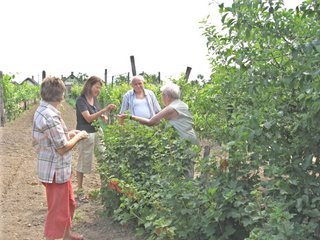 Amongst the fruit bushes, Gyömöre
Amongst the fruit bushes, Gyömöre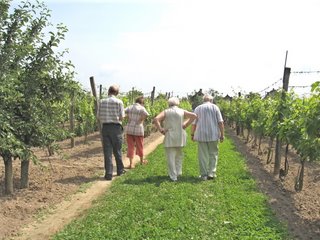 Up the garden path, Gyömöre
Up the garden path, Gyömöre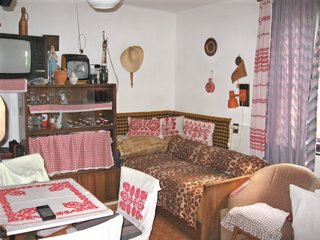 Inside the garden house, Gyömöre
Inside the garden house, GyömöreWe were taken down into the cellar. It had a distinctive and delightful musty smell of fermented wine and seemed icy cool after the heat of the garden but apparently was not really cold enough for storing the large round wicker-covered bottles of white wine. To prove it we were given clear chilled glasses of deep yellow wine to try. They seemed cold to us and were deliciously palatable. So we were given a large bottle to take away with us! Erzsébet's father makes his wine using the old traditional methods which he was happy to show us and explain in Hungarian.
 Erzsébet and her father in the wine cellar, Gyömöre
Erzsébet and her father in the wine cellar, Gyömöre In the wine cellar beneath the garden house showing traditional equipment, Gyömöre
In the wine cellar beneath the garden house showing traditional equipment, GyömöreBack in the garden we sipped strong coffee and nibbled peas, strawberries and cherries, soaking in the magic atmosphere and listening to the birds as they helped themselves to the ripening cherries on the trees.
 Erzsébet and her mother under the arbor, Gyömöre
Erzsébet and her mother under the arbor, GyömöreIt was only lunch-time when we left. It felt as if we'd been up all day, so used are we to it taking a couple of hours each morning sorting ourselves out in Modestine.
Back home Gábor set about preparing lunch. He apparently loves cooking while Erzsébet preferred to chat with Ian about local studies developments in Hungarian and British libraries. Meanwhile we kept cool with yet more glasses of chilled wine from the garden house. All this may sound idyllic. That's simply because it was.
After lunch we thought we would drive into Györ together to explore the town. The temperature in Gábor's car registered 55 degrees! Gábor's very practical solution was to drive as fast as possible, bouncing over the potholes, to create sufficient draught to cool us down.
There was not a lot of traffic or people in the town on a hot Sunday afternoon. It is a very attractive town of about 135,000 inhabitants with whole streets of unspoiled baroque facades and cobbled streets. Down where the rivers Rába and Danube meet in the town there are a pretty, shady park and a swimming pool. (Jill continues to long for the opportunity to swim but circumstances continue to perversely prevent it.)
 This is proving rather an interesting new hobby! Györ
This is proving rather an interesting new hobby! Györ Széchenyi tér, Györ
Széchenyi tér, Györ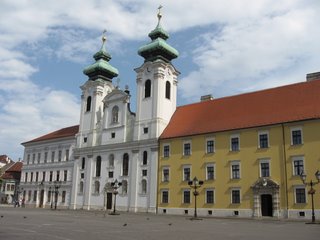 Benedictine Church, Széchenyi tér, Györ
Benedictine Church, Széchenyi tér, Györ Typical street of Baroque buildings, Györ
Typical street of Baroque buildings, Györ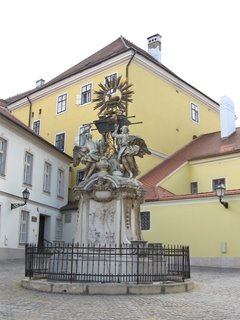 Ark of the Covenant, Gutenberg tér, Györ
Ark of the Covenant, Gutenberg tér, Györ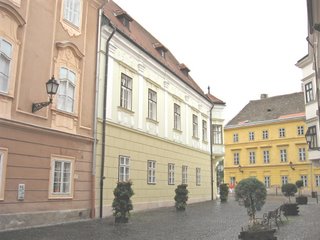 Stucco decorations and corner windows, Györ
Stucco decorations and corner windows, GyörAt the main theatre there was a free concert of gypsy music taking place. We bought cold beers and sat on a nearby bench under a tree to listen. So quintessentially Hungarian, this music developed by the country's large gypsy community is played in a popularised form for tourists, especially in expensive restaurants in Budapest. It is less usual to hear folk groups playing. Both forms are charming to our ears though our companions were more discerning. Two groups of musicians had joined together for their recital and Erzsébet was convinced they were not completely synchronised. Played on violins, with cimbalom and clarinet accompaniment it must surely be one of the most difficult of music genres to perform well. The speed and cadence vary to extremes with pauses in the tunes for each player to show off his relationship with his instrument. So there can be the vibrant, swirling flow of incredibly fast ensemble performance alternating with the haunting, high sound of a single violin imitating bird song. This in turn will give way to the unique sound of the cimbalom solo with the violins and clarinet gradually picking up the tune again. Much is improvised but there are particular tunes that are recognised and loved by the audience. (We have a CD of such music. When we return to Exeter anyone interested can come over to experience Jill's newly discovered culinary skills with bean stew and gnocci, served by Ian in his tee-shirt to the accompaniment of our CD. Cheaper and easier than all this travelling for everyone!)
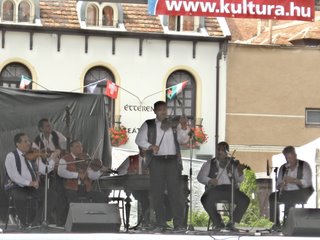 Gypsy band in front of the theatre, Györ
Gypsy band in front of the theatre, Györ Listening to the band, Györ
Listening to the band, GyörBy the edge of the main square we were joined on the cool terrace of a coffee shop by our friends' younger daughter Zsuzsa and her boyfriend. Like her mother and sister, Zsuzsa has studied English. She teaches it to the Hungarian army as her work. The worst of the afternoon's heat was spent most agreeably with ice creams and cold drinks, chatting and translating for those silly English visitors who are incapable of understanding Hungarian.
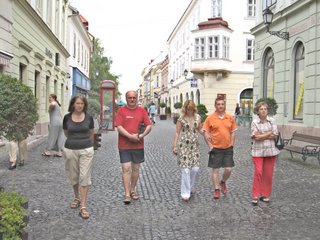 On our way for some refreshment, Gyömöre
On our way for some refreshment, GyömöreWe returned to Gyömöre where we ate supper outside under the pergola. There are fewer insects here than on our last campsite but it is certainly not devoid of mosquitoes so we were soon forced inside.
Tuesday 20th June 2006 Gyömöre, near Györ, Hungary
It is quite impossible to keep the blog current when we are with friends so we are once again writing up the events of the previous day over breakfast as we sit in the shade which we share with the large family dog, Erzsébet and Gábor having left for work well before 7am.
Yesterday was fairly lazy. Erzsébet is Deputy County Librarian and spent the morning evaluating one of the local libraries for its accreditation – yes they have such stressful unpleasant things here too! Because it was nearby she was able to return home for lunch.
 Deputy County Librarian at home on her lunch break, Gyömöre
Deputy County Librarian at home on her lunch break, GyömöreDuring the afternoon she had another visit to make to a village library where there are plans to replace it with a mobile. This is a new concept in Hungary and as with Katalin in Pécs, there is much discussion about requirements for tender. We were invited to accompany Erzsébet and take a walk while she interviewed the librarian and the mayor at the library.
So while she worked, we took a stroll through the pretty little village of Bakonygyirót, moving slowly between patches of shade. We crossed the railway track – hundreds of them all over Hungary and all of them with unmanned level-crossings and no more than a flashing light to warn of advancing trains. Rarely is there any form of descending barrier.
 Main street of Bakonygyirót
Main street of BakonygyirótBeyond the main limits of the village the fields of wheat and peas stretched out in the sunshine and we followed an unmade track edged with poppies, marguerites and wild forget-me-nots up a slight slope leading to woodland.
 Open countryside near Bakonygyirót
Open countryside near BakonygyirótBeyond we discovered a remarkable area. The slopes were covered in vines, each plot being individually owned and each having its own pince or wine cellar. They gave the appearance of a rural street of tiny cottages, some with thatched roofs, all with trimmed grassy lawns in front and vineyards behind. At intervals were old wells with buckets for raising the water. It seemed like stepping back through time to a rural village centuries ago. In the heat of the afternoon nothing stirred and it seemed deserted. We were hot beyond belief and having reached the upper limits of this wine "village" we returned slowly down the road again.
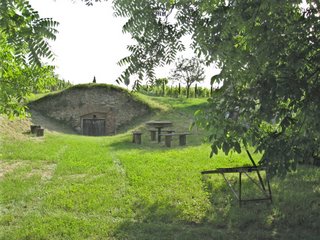 Pince with vines growing beyond, near Bakonygyirót
Pince with vines growing beyond, near Bakonygyirót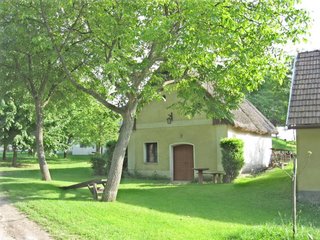 Thatched pince, near Bakonygyirót
Thatched pince, near BakonygyirótThis time we saw a couple of men drinking glasses of wine at the open door to their cellar, their two dogs lying asleep in a very battered old Trabant parked under the shady tree in front. Madness from the heat must have gripped us as we simply walked up to them and asked in Ian's best Hungarian whether we could buy two glasses of white wine! They were somewhat surprised but quite charming. They only had four glasses anyway and had simply come up to test the progress of the fermentation but willingly washed the spare glasses out in well water for us, took us into the dark, icy interior and explained they were in the process of enlarging the cellar, showing where they were excavating out space for more wooden barrels under the vineyard on the hillside above. Wine was sucked out of one of the barrels with a pipette and decanted into a battered jug. Back under the tree at the entrance they found us a couple of chairs, sat us down and filled our glasses to the brim, topping up their own and joining us in a cheerful "egészégunkre". They chatted happily away under the assumption we understood far more than we did but Ian was so chuffed, exclaiming to me that he never dreamt he's actually find himself almost holding a conversation entirely in Hungarian! In fact, because it was all so natural we did understand quite a lot. We asked, and they explained, about the use of some of the old equipment lying around on the grass and they explained jokingly that their Trabant was the "deluxe" model – top of the range! It certainly made a very good kennel for the dogs. When we tried to pay for the wine they flatly, but charmingly refused. We would never have dared ask if we had thought payment would be refused! They were curious to know how we came to be walking around, miles from anywhere and with no transport. Somehow Ian explained we were waiting for a friend in the village. When we finished our wine and went to leave they insisted we have another glass. Explaining the sun was already making us wobbly they added chilled fizzy water for us. Despite our secret horror at spoiling wine like this it actually tasted very good on a hot day with a wine that was still so young.
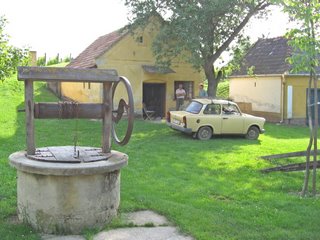 About to meet some new friends, near Bakonygyirót
About to meet some new friends, near Bakonygyirót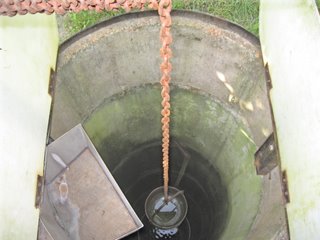 The well shaft with bucket, near Bakonygyirót
The well shaft with bucket, near Bakonygyirót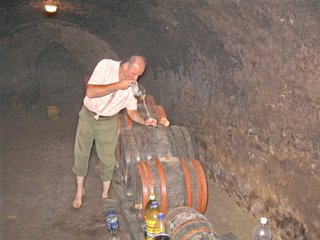 Wine from the barrel, near Bakonygyirót
Wine from the barrel, near BakonygyirótWe all shook hands and they waved us off as we wended our wobbly, wandering way down the track to the village, hoping the mayor would not notice we were rather more red and jolly than when we had met him a couple of hours earlier.
Poor Erzsébet had to suffer us excitedly telling her of our adventure while she had spent a far less enjoyable afternoon. Back home Gábor arrived soon after us and we crossed the road to the village inn – almost like a British pub serving drinks, meals, snacks and even ice creams. Here we were joined for a beer by Erzsébet's parents who were there arranging her father's birthday party for later in the month. Finally we returned home and while Gábor cooked an amazing supper of pork, bacon, cheese and mushrooms served with rice and peas, we were sent off with the dog to the garden to gather a large bucket of peas and a smaller container of raspberries. Over supper in the darkness of the garden we phoned Elizabeth in York, a librarian and mutual friend who is particularly close to Erzsébet and has visited Gyömöre several times before. She sounded happy to hear from us all so we hope she is not too cross with us for being here while she is working back in England. (Erzsébet has asked us to make this blog particularly interesting in the hope it would lure you over here Elizabeth as she is eager to see you again. We are doing our best. She and Gábor both send their love. )
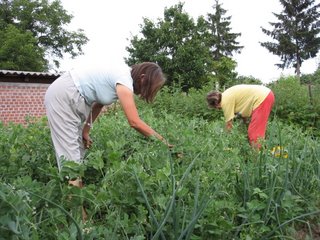 Picking peas in the garden, Gyömöre
Picking peas in the garden, GyömöreWednesday 21st June 2006 Gyömöre, near Györ, Hungary
It is 7am and we are finally getting into the Hungarian habit of starting the day early. Our hosts set off for work at 6am which was rather too early for us to be active despite the sun already having been up for ages. Time now to catch up on yesterday.
After an early lunch we took the train into Györ from the village station. This is very near the house and is something like the rural stations that were Beechingised in Britain back in the 1960s. The line is single track and the hot, exposed platform is one of the gossip spots of the village with everyone arriving in plenty of time for the very few trains that pass along the line. This ensures they have the opportunity to catch up on local news. By the time the train arrives the platform is quite crowded. Unaware of this we arrived with just a few minutes to spare only to find the lady in the ticket office doubles up as gossip co-ordinator and is a mine of information on village daily life. We were beginning to panic that the train would arrive before the discussion on the quality of Mr. Bartok's silage crop had terminated.
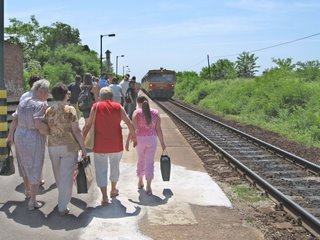 Arrival of the train to Györ, Gyömöre
Arrival of the train to Györ, GyömöreThe journey into Györ was slow and hot. Someone complained about the window being open (it was 32 at 5.30pm in the shade here yesterday) and there was a bit of arguing. The window was finally closed and we all broiled until the terminus. The train trundled slowly through the open countryside of wheat sprinkled with poppies and tall deep blue flowers unknown to us. It stopped at all the pretty little villages, each house with its own garden of vegetables, fruit trees and roses. At one station it really became unbearably hot as we waited at the passing point for the approaching train, still somewhere down the single track.
We spent a very pleasant afternoon exploring the streets of the old part of Györ which confirmed our opinion of Sunday that it really is a delightful place with nothing to jar. Buildings have been sympathetically restored and the main centre is pedestrianised. This makes it calm and safe to wander in. There are little fountains and some very nice statues. We found the Baroque cathedral, deserted but wonderfully cool inside. It has strong connections with Ireland and holds a miraculous painting of the virgin. Apparently it came to the town after an exiled Irish priest was offered a safe haven in Györ and left it to the cathedral on his death. On St. Patrick's day, 17th March 1697 the virgin was seen to be weeping tears of blood. This continued throughout the day and has been authenticated as a miracle. Apparently a cloth was used to wipe away the blood, of which traces still remain on the conserved cloth today. (So maybe it would be possible to carry out a DNA test on the painting to find the genetic make-up of Christ? After all, 50% must come from his mother and who knows, would God the Father have had DNA? Presumably not.)
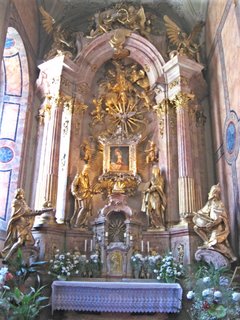 Side altar in the cathedral showing the miraculous painting, Györ
Side altar in the cathedral showing the miraculous painting, GyörAn ice cream in the shade and a peep inside the first real department store we have encountered in Hungary both offered blessed relief from the temperature. Then it was time to make our way to the library where Erzsébet and the library director were waiting for us. We were offered cold drinks in the director's large office, lined with paintings and rare books and graced with a bronze statue of a decapitated Guttenberg, an operation undertaken accidentally by a builder's ladder. Ian and the director, Joszef Horváth, had met previously when Ian made his study tour in 1996. They both have a strong interest in rare books and were fortunately able to communicate enthusiastically using German. Ian marvelled at a newsbook giving an eyewitness account of the recapture of Györ from the Turks in 1596 and at the first item printed in the city – an almanac in red and black dating from 1725 with German and Latin texts and manuscript annotations on the weather, unusually for that period in Hungarian. They use a craft binder in Szentendre to conserve their rare books. We were given a tour of the four-storey county library building, housed in a former bank. (Anyone particularly interested in the library perspective please contact us. Ian has a detailed report from his earlier visit, although this does not reflect recent developments.) The local history librarian remembered Ian and spoke excellent English so that was obviously an area that was of particular interest for us. They are very up to the minute in some respects and have even started making digitised newspapers available – something that Devon has yet to accomplish.
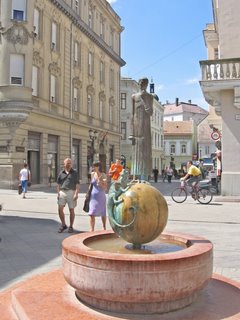 County library building and statue of St. George, Györ
County library building and statue of St. George, GyörWork starts early in Hungary and theoretically finishes early. Around 4.30pm we walked across town to visit Erzsébet's daughter Erzsébet and the grandchildren. Here we were joined by Gábor and Andrasz. The children kept us all amused. They must be exhausting to care for 24/7 in such temperatures though their flat is cool and spacious with a shady balcony.
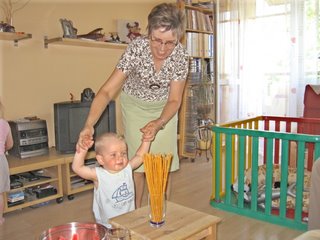 Erzsébet with her grandson
Erzsébet with her grandson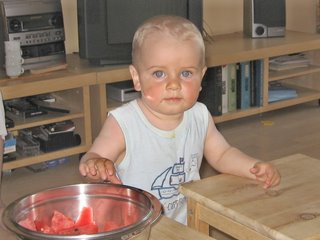 Erzsébet and Gábor's grandson
Erzsébet and Gábor's grandson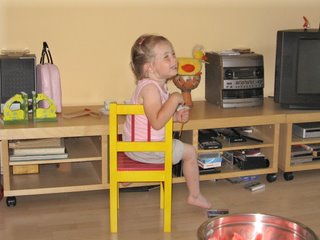 Erzsébet and Gábor's granddaughter Lutha
Erzsébet and Gábor's granddaughter Lutha Afternoon tea is prepared for us
Afternoon tea is prepared for usFinally we returned by car to Gyömöre where we were joined by Erzsébet's parents for supper which we ate across the road at the village inn. There were only three choices on the menu and we were advised to try the fish soup. Normally we avoid this in England, finding it too salt but we were told it was river fish rather than sea fish. Unfortunately for us Hungarian's seem to enjoy more salt in their meals than we are accustomed to and we still found it rather salt for our taste but otherwise very nice. Others had bableves – bean soup with a knuckle of pork, and fish cutlets marinaded for several days with onions in pickling vinegar, salt and sugar.
Back at the house, Gábor and Ian settled with a beer apiece to watch the football match, England versus Sweden in Germany. (Sweden equalised in the 90th minute – we was robbed!) Jill and Erzsébet made their excuses and disappeared to bed.
That concludes yesterday. Now for today, Wednesday 21st June…..
This morning we arrived at the railway station, just a few metres from this house, for the 11.20 train to Pápa, down the single track in the opposite direction from Györ. Not many trains actually stop at this little rural station but occasionally there is even a direct train to Budapest if you are patient enough to visit every village on the way! Our train failed to arrive as we had committed the unpardonable offence for librarians of reading the timetable incorrectly. Our only excuse is that it was in Hungarian and rather complicated. The next train would not be arriving for an hour. So we returned to the house and got ourselves lunch, re-appearing at the station in time to pick up the Budapest train on it way through. This was something quite from the past with a corridor and individual compartments. It was old and battered with plastic seats quite unsuited to the hot summer weather. It had obviously never been renovated since at least 1989 and still carried signs and regulations in Russian. We stood in the corridor as we made our way along the line, benefiting from the warm breeze from the open window.
 Remember these? Budapest "Express"
Remember these? Budapest "Express"At Pápa we discovered the town centre is some distance from the station and the streets were hot, airless and lacking shade. The weather is such that we were quite exhausted by the time we did finally reach the centre. Jill got so ratty at one point she sat like Humpty Dumpty on a wall in the only patch of shade along the road refusing to go any further to see yet more baroque churches and castles. Where was the swimming pool! Poor Ian! Eventually, as there was no alternative, she grumbled her way along and we eventually reached the town, where both the Baroque church and the castle rewarded us with their dark, cold interiors.
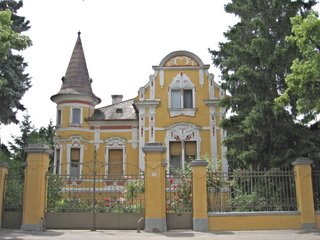 Pretty house in the suburbs of Pápa
Pretty house in the suburbs of Pápa Main shopping street, Pápa
Main shopping street, PápaPápa means Pope in Hungarian and is something of a misnomer for a little town that is essentially Calvinist Protestant with an important college which once rivalled that in Debrecen. It is a pretty place with whole streets of stuccoed, decorated houses from the 18th century and a park in what they fondly call English style leading up to the Esterházy Castle. Once an imposing Baroque building dating from the 1780s, it stands somewhat neglected and in need of restoration. It provides several council services including the local history museum and a theatre. The main church was built for Count Karoly Esterházy, Bishop of Eger - the family seems to have owned half of eastern Hungary and were influential in many areas. The cool interior was dominated by the trompe l'oeil ceiling paintings of the life of St Stephen the martyr by the Austrian Maulbertsch.
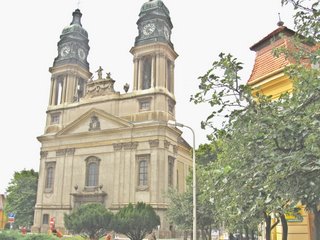 St. Stephen's church, Pápa
St. Stephen's church, Pápa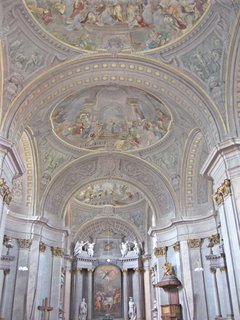 Splendour was surpassed by cool comfort, St. Stephen's church, Pápa
Splendour was surpassed by cool comfort, St. Stephen's church, Pápa Esterházy Castle, Pápa
Esterházy Castle, PápaAround the town we stopped at the doors of wine bars and supermarkets to enjoy the draughts of cold air from the inside. We bought lemon water ices and iced water but nothing alleviated the hot sticky heat.
Unable to cope any longer we returned slowly to the station and sheltered in the buffet waiting for the next train back to Gyömöre. Confusingly for Jill this train too was going to Budapest! Ian patiently explained that it was some sort of loop and the lines eventually joined up.
Outside the village station as we returned we found a horse and cart waiting in the heat to collect goods sent down the line. Horses and donkeys are used almost as commonly as vans and lorries around the village.
 Railway station and local traffic, Gyömöre
Railway station and local traffic, GyömöreAround 6pm shadows were longer and we ventured on a walk around the village which is very pretty and typical of those described earlier. We received several curious looks from elderly residents but also more than one cheerful "szia", pronounced "see ya" which we find as strange as a greeting as we do "hello" for "goodbye".
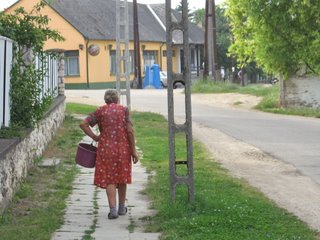 Village scene, Gyömöre
Village scene, Gyömöre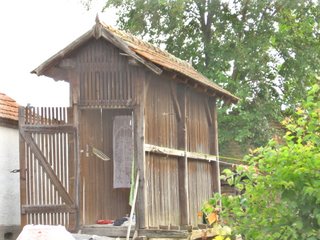 Drying rack, presumably for silage, Gyömöre
Drying rack, presumably for silage, Gyömöre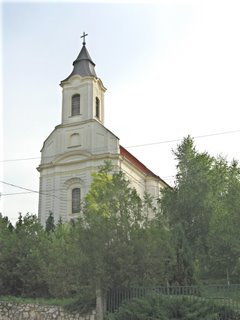 Church, Gyömöre
Church, GyömöreAfter cold showers we joined Erzsébet and her parents under the pergola where the temperature had now plummeted to a mere 30 degrees, for supper. Her dad says the weather is now more typical of late July. Strange to recall that we were cold and wet in Debrecen such a short time ago. Erzsébet's mum had spent the day making rétes in her country kitchen and willingly explained the secret of getting the thin layers of delicate pastry just right. After paprika pea soup made from our recent harvest we poured ourselves chilled glasses of wine from the garden house cellar and enjoyed the huge plate of assorted rétes. There was cream cheese with raisins and lemon zest, sweet, sticky poppy seed and even sweeter dark red cherry. (Kati and Peter, are you filled with nostalgia?)
 Garden supper in Gyömöre
Garden supper in Gyömöre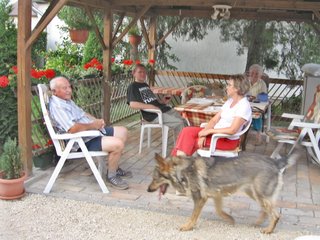 Relaxing with the family over supper, Gyömöre
Relaxing with the family over supper, GyömöreErzsébet's mum explained that she had been born in this house, now occupied by Erzsébet and Gábor. It had been built by her parents back in the early 1920s, right near the station, as her father had been the station master. How fascinating for us to imagine life in a country village going on for generations, the same house seeing different children growing up. Now of course things have changed. The well still stands in the garden but is used only for watering the vegetables. There are now all the conveniences of electricity – washing machines, dish washers and computers. But outside in the road and at the railway station, there since the 1870s, the changes are less obvious. Even the fields probably look similar with their crops of wheat and scythed grass and roadside verges filled with wild flowers.
All things come to an end. Tomorrow we move on to Sopron and probably out of Hungary. We said our farewells to our friends as they will be gone to work before we are up tomorrow. Staying with them has been a delightful interlude and fully expresses just why we have nurtured the desire for so long to spend an entire year travelling around Europe visiting some of the many friends we have made over the years. Who knows when the opportunity will occur again. Leave-taking under such circumstances is tinged with sadness. It is the price we have to pay for the pleasure of seeing our friends like this. Thank you everyone here in Gyömöre and Györ, especially Erzsébet for so much laughter, for translating and for professional friendship, and thank you Gábor for the wonderful cooking!
 Jill and Buski finally get on the blog, Gyömöre
Jill and Buski finally get on the blog, Gyömöre